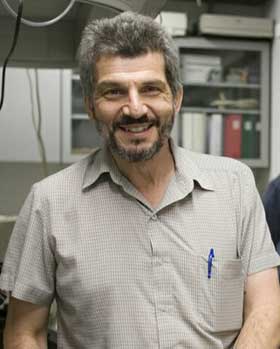News Archives - 2013
Shedding light on everyday physics experiments
 Dozens—if not hundreds or even thousands—of physics experiments go on every day on the Augsburg College campus. Most of the time, however, no one hears about these experiments. No one knows if the experiments yielded favorable results that can be duplicated. No one knows if the experiments were a waste of time and resources. No one reports the results to anyone, and no one tracks the cost of the experiments.
Dozens—if not hundreds or even thousands—of physics experiments go on every day on the Augsburg College campus. Most of the time, however, no one hears about these experiments. No one knows if the experiments yielded favorable results that can be duplicated. No one knows if the experiments were a waste of time and resources. No one reports the results to anyone, and no one tracks the cost of the experiments.
Yet, each and every day, Augsburg College students conduct physics experiments whenever they cook or prepare food. Harvard University's David Weitz will make visible the everyday physics taking place during food preparation at the Sverdrup Visiting Scientist lecture.
In addition to making science more accessible to non-scientists, the lecture provides important opportunities for Auggie science majors to hear from and network with leaders in the scientific community. Often, these experiences can grow into valuable internships or chances to study off campus and may be the starting point for Auggies to begin their careers.
The physics of our foods
Weitz, a professor of physics and applied physics and head of the experimental soft condensed matter group at Harvard, studies soft materials, such as the whipped cream on your banana split and squishy materials such as the yogurt and jello in your refrigerator. The study of soft condensed matter also includes biological materials such as blood, muscle, or milk. These materials often have properties of both liquids and solids. Understanding how these materials behave in different forms can have important technological applications.
Weitz, who also teaches an introductory science course on the physics of food, will explore in his Monday, April 8 lecture, "Physics of Cooking," the science behind innovative approaches to taste and presentation used in modern cooking, including "food foams" and the use of "gelation," which means solidifying a food by cooling or freezing it.
Weitz will discuss how foods change during cooking as a way to illustrate the scientific processes that people experience in daily life. By understanding the chemical and structural changes that occur during regular food preparation, attendees will be able to more easily relate to the actual scientific terms, processes, and disciplines including soft matter physics, materials science, and organic chemistry.
Studying physics in the Augsburg kitchen
Augsburg College associate professor Ben Stottrup, who teaches a course on the physics of cooking at Augsburg, said food is a way to get people interested in science—perhaps enough to change their degree program. One student wrote in a midterm evaluation: "My perspective on science has changed dramatically. I really enjoy how science is so mysterious yet so explainable at the same time. Makes me want to major in science."
Strottrup's course uses cooking and food—called a "biomaterial" by scientists—to present scientific concepts and processes. For example, students make mayonnaise to learn about how liquids can be combined. The egg yolks and oil used in mayonnaise would not naturally mix together, but by slowly whisking the oil into the egg yolks, the two liquids form what is called a permanent emulsion that won't separate.
Stottrup's course also includes labs that use tofu and steak to understand how materials resist or react to changes in shape, whipping cream to learn about foams, and melting chocolate to demonstrate the transition of matter from solid to liquid.
Several of Stottrup's students said in their midterm evaluations that the course has helped them see the science around them and to be more aware of how science affects them. Another student said, "Before Science 123 I could have never imagined thinking about food scientifically. It has made me really think about the material properties in the foods that I like to eat, and in my mind, make better eating choices. I'm now curious [about] what I eat... and what [foods] will do for me when I eat them."
The magic of microfluidics
The Tuesday convocation lecture, titled "Dripping, Jetting, Drops, and Wetting," explores microfluidics, the science of the behavior, control, and manipulation of fluids that are constrained to a small, typically sub-millimeter, scale.
Because fluids behave differently in small channels, scientists use microfluidics to study how behaviors change and how to work around or exploit these changes for new uses. Weitz will discuss the use of microfluidic devices to precisely control the flow and mixing of fluids to make drops, which have a variety of practical applications from cosmetics to drug testing and delivery.
The Sverdrup Visiting Scientist program
The annual Sverdrup Visiting Scientist lecture series brings renowned scientists to campus to share their expertise with the Augsburg community, the College's aspiring scientists, and members of the larger scientific community. The program provides an opportunity for Augsburg students and faculty to interact on a personal basis with scientists of national stature.
The General Leif J. Sverdrup Visiting Scientist program was established in 1990 by Johan Sverdrup in memory of his father, Major General Leif J. Sverdrup '18. General Sverdrup was the founder of Sverdrup and Parcel, Inc. (now the Sverdrup Corp.), an international architectural and engineering firm.
Sverdrup Lecture Event Schedule – all events are free and open to the public
Monday, April 8, 7 p.m.
Hoversten Chapel, Foss Center
"Physics of Cooking"
Tuesday, April 9, 11 a.m.
Hoversten Chapel, Foss Center
"Dripping, Jetting, Drops, and Wetting: The Magic of Microfluidics"
Convocation Hashtags
Share your convocation experience using social media. The hashtag for the Sverdrup Visiting Scientist lecture with David Weitz from Harvard (@Harvard) is #SverdrupConvo.